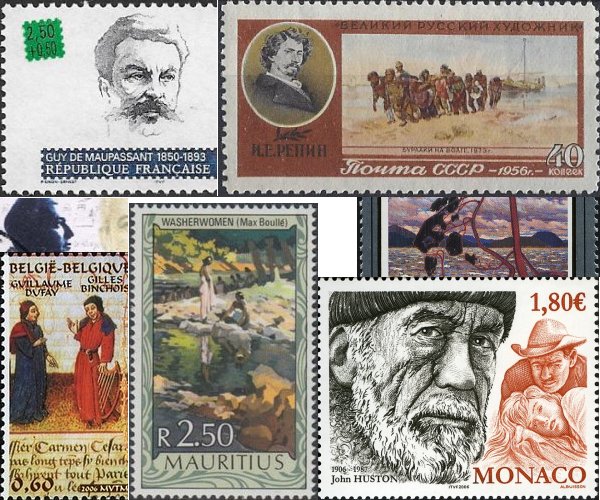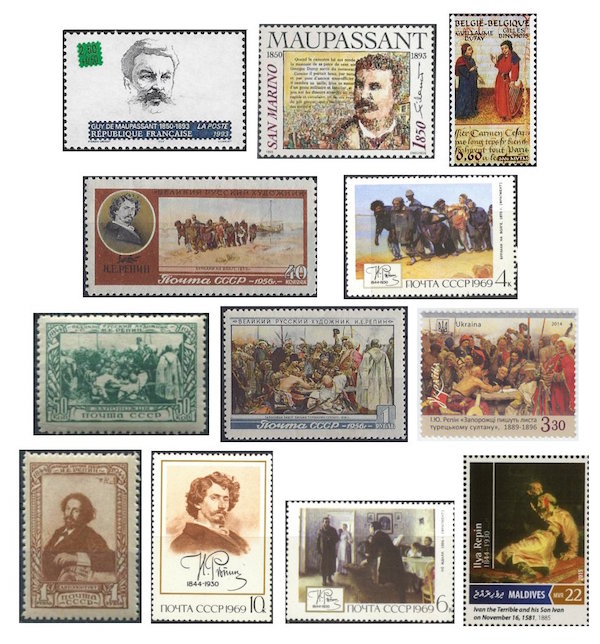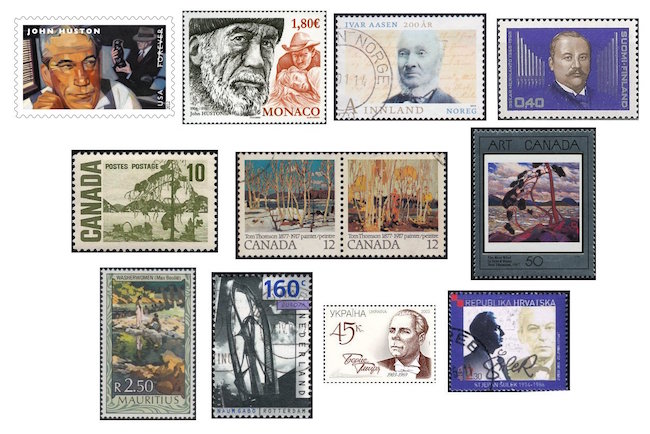The Arts on Stamps of the World — August 5
An Arts Fuse regular feature: the arts on stamps of the world.

By Doug Briscoe
Today is the birthday of the great French writer of short stories Guy de Maupassant (1850 – 6 July 1893). Just two stamps, one French, one from San Marino.
It seems we know the birthday, but not the birth year, of Guillaume Dufay, one of the greatest composers of the early Renaissance. (I used to think of him as a Medieval composer, but then I used to think Jupiter had twelve moons.) Sources tell us he was born on August 5, circa 1397, and died on November 27, 1474. He was a Franco-Flemish composer of the Burgundian School, regarded by his contemporaries as the most important composer of his day. In the Belgian postage stamp of 2006, he is shown with his contemporary Gilles Binchois (c1400-1460).
Ilya Repin (5 August [O.S. 24 July] 1844 – 29 September 1930) was the most important Russian painter of the 19th century. He studied surveying at military school, then turned his hand to the restoration of icons and to portraiture before going off to the St. Petersburg Art Academy. In 1870 he traveled to the Volga to study local color, and the result was one of his most famous pictures, Barge Haulers on the Volga (1873), which seems to cry out for the Volga Boatmen’s Song by way of musical accompaniment. This painting shows up on two Soviet stamps from sets honoring Repin, one from 1956 and one from 1969. After travels to Italy and France with his family, he took up residence in Moscow and met Tolstoy, whom he would later paint twice. In the 1880s Repin embarked on a number of significant portraits, including the famous one of Mussorgsky. It was also at this time that he began work on what would become probably his most celebrated painting, Reply of the Zaporozhian Cossacks (1880–91), seen on two Soviet stamps and one from Ukraine. Repin visited the region twice, first in 1880 and again in 1888, for research for this art work, which recreates the scene in 1676 when unruly Cossacks drafted their vulgar response to the demand of the Ottoman Sultan Mehmed IV that they submit to him and cease their raids on his territories. Besides a couple of self-portraits, two other well-known Repin pieces can be seen here: Unexpected Visitors (c1886) and Ivan the Terrible and His Son Ivan on November 16th, 1581 (1885) on a stamp from the Maldives.

Here are a few interesting factoids I learned about the great American director John Huston (August 5, 1906 – August 28, 1987). His parents—his father, of course, was the distinguished actor Walter Huston—were divorced when he was six. In childhood he had to be treated for heart and kidney problems, but by his mid-teens he was a successful boxer. In his twenties he was a portrait painter in Paris and an honorary member of the Mexican cavalry. In 1993 he hit and killed a young woman with his car, but was exonerated of any culpability. He was such a success as a young screenwriter that Warner Brothers promised him he could direct a movie if his next script was a hit. It was (High Sierra), and the project he chose for his directing debut was The Maltese Falcon. (That classic film is referenced on the American stamp of 2012, one of four honoring great American directors.) His fourth wife Enrica Soma, the mother of actress Anjelica Huston, had an affair—and a child—with the brilliant historian John Julius Norwich (I vigorously recommend his magnificent Byzantium trilogy). Another of Huston’s great films, The Misfits, with Clark Gable and Marilyn Monroe, was chosen for the design of the Monagasque John Huston stamp from 2006.
The extraordinary Norwegian philologist and lexicographer Ivar Aasen (5 August 1813 – 23 September 1896) essentially codified one of the two official variants of the Norwegian language, Nynorsk (New Norwegian). The purpose was to create a distinct Norwegian tongue based on older forms so as to shed the Danish-inflected Norwegian that had grown dominant in intellectual circles as a result of the two countries’ historical union from the 16th to the early 18th centuries. (It’s complicated. As it stands, the Danish-influenced version, Bokmål, is still spoken by the vast majority of Norwegians, but the government has recognized both versions as having equal standing, with older schoolchildren required to learn both.) Conversant with many languages, Aasen wrote plays and poetry using Nynorsk, besides creating a number of volumes on grammar.
Oskar Merikanto (1868-1924) performed throughout his native Finland on organ and piano, as well as conducting opera. He wrote three operas of his own, along with much incidental music for the stage. Otherwise his compositions are largely restricted to shorter forms: a great many piano pieces, choruses, and songs. His son Aarre Merikanto (1893-1958) was one of the more prominent Finnish composers.
Regular readers of this feature (and people who are knowledgeable about the fine art of Canada) will recognize the name of the important Group of Seven, several of whose members we’ve saluted here. Although he died before the group’s official founding in 1920, the painter Tom Thomson (August 5, 1877 – July 8, 1917) is credited with having given the group its initial impetus. Born and bred in Ontario, Thomson apparently showed no pronounced artistic leanings until he began working for a photo engraving firm at about the age of thirty. Shortly thereafter, he switched to the art design company Grip Ltd., which would become the incubator for the initial members of the Group of Seven. By 1913, he had decided to become a full-time artist. Thomson loved nature—he would also work as a firefighter, ranger, and guide—and he died of (probably) accidental drowning while canoeing. His work can be seen on four Canadian stamp issues: the earliest and latest chronologically show two of his most celebrated canvases: The Jack Pine (1916-17) and The West Wind (1917). The pair of stamps in between offers April in Algonquin Park and Autumn Birches.

Max Boullé (5 August 1899 – 18 May 1896) was a painter and architect born on the island of Mauritius. He studied in Paris and designed several buildings there, as well as working in theater. As for his paintings, they generally reflect the local landscape and daily life, as in Washerwomen (see the stamp) and South Coast (c1960).
Russian-Jewish sculptor Naum Gabo, a leader of Constructivism and one of the first to explore kinetic sculpture, was born Naum Neemia Pevsner on this date (O.S. 24 July) in 1890. His elder brother Antoine Pevsner was also an artist, and Naum changed his name to avoid confusion with his more celebrated sibling. Gabo studied engineering in Munich and spent the war years in Paris, Copenhagen, and Oslo. After living for five years in Moscow, Gabo, finding that his work was not congenial to Socialist Realism, went back to France and Germany (he spoke both languages fluently, as well as English). He provided the designs for Serge Diaghilev’s Ballets Russes production of La chatte (1926, music by Henri Sauguet) and was teaching at the Bauhaus in 1928. He spent most of the early thirties back in Paris, then relocated to London and Cornwall and finally, in 1946, to the United States. He died in Connecticut on 23 August 1977. A structure he created for the city of Rotterdam in 1957 is shown on a Dutch stamp of 1993.
Stjepan Šulek (1914 – 16 January 1986), a Croatian, was born in Zagreb and in his early years was mostly active as a violinist in recitals and chamber music. He began teaching at the Zagreb Conservatorium in 1939. Later he was busy throughout Yugoslavia as a conductor. He wrote eight symphonies, ten concertos for various solo instruments, a further four “Classical Concertos” for orchestra, ten string quartets, two operas, a ballet, etc.
Shostakovich had Ukrainian bass Boris Gmyrya (Hmyrya) (1903 – 1 August 1969) in mind for the solo part in his “Babi Yar” Symphony (no. 13), but Gmyrya backed out from the première because of the controversial nature of the texts. Yevtushenko’s poems were critical of Soviet attitudes, anti-semitism in particular, and Gmyrya had already suffered ostracization for having performed for German occupiers during WWII. He was punished by being given insultingly unsuitable roles (even tenor roles!) until he withdrew from the opera stage and concentrated on song recitals. And yet he was named People’s Artist of the USSR in 1951 and was awarded the Stalin Prize in 1952. I was struck by a sad analogy with recent activity here in the US. Nikita Khrushchev attacked Yevtushenko by accusing him of putting the suffering of the Jews above that of the Russian people as a whole. This reminds me of the response in some quarters to the phrase “Black lives matter”: “All lives matter”, which, of course, entirely misses the point.
A word for the stampless: the fine American writer Conrad Aiken was born on this day in 1889 (died August 17, 1973).
A graduate of the University of Massachusetts with a B.A. in English, Doug Briscoe worked in Boston classical music radio, at WCRB, WGBH, and WBUR, for about 25 years, beginning in 1977. He has the curious distinction of having succeeded Robert J. Lurtsema twice, first as host of WGBH’s weekday morning classical music program in 1993, then as host of the weekend program when Robert J.’s health failed in 2000. Doug also wrote liner notes for several of the late Gunther Schuller’s GM Recordings releases as well as program notes for the Boston Classical Orchestra. For the past few years he’s been posting a Facebook “blog” of classical music on stamps of the world, which has now been expanded to encompass all the arts for The Arts Fuse.
